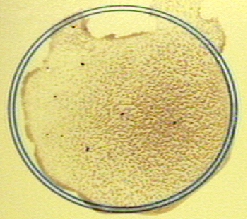16.3.3: Serologic Tests for Infectious Mononucleosis
- Page ID
- 122739
During infectious mononucleosis, caused by the Epstein-Barr virus (EBV), the body produces non-specific heterophile antibodies which are not found in normal serum. As it turns out, these heterophile antibodies will cross react with glycoprotein antigens found on the surface of red blood cells (RBCs) of various animals, including horses, sheep, and cows, causing the RBCs to agglutinate. These cross-reacting glycoprotein antigens are often called Paul-Bunnell antigens after their discoverers.
The infectious mononucleosis serologic test demonstrated today is a rapid qualitative test for infectious mononucleosis called the ASI Color Mono II Test®. The mono reagent in this test is a suspension of dyed, color-enhanced, preserved horse erythrocytes. The Paul-Bunnel antigens in the cell membrane of these horse erythrocytes are highly specific for mononucleosis heterophile antibodies and act as the "known antigen." Agglutination of the erythrocytes after adding the patient's serum indicates a positive test (see Fig. \(\PageIndex{1}\)). Quantitative tests may be done to determine the titer of heterophile antibodies and follow the progress of the disease.

Contributors and Attributions
Dr. Gary Kaiser (COMMUNITY COLLEGE OF BALTIMORE COUNTY, CATONSVILLE CAMPUS)


